Let’s say you are building a serverless application with AWS (Amazon Web Services) Lambda. Now, if you want to automate function deployment, you will most likely do so via CI/CD (continuous integration and continuous deployment) workflow.
But integrating Lambda into a DevOps pipeline requires additional underlying plumbing. For instance, managing multiple configurations of the serverless framework functions and related resources (such as API Gateway, IAM policies, CloudWatch log groups).
Plus, there are added challenges such as interfacing with multiple programming languages or dealing with a large number of microservices. Hence, despite its countless benefits, serverless comes with a catch.
It is where serverless deployment frameworks step in. They are tools to enable developers to deploy serverless infrastructure quickly and seamlessly. While AWS offers first-party tools for serverless technology, various third-party frameworks are available in the market for deploying serverless applications.
This blog post talks about some popular serverless frameworks used today for deploying applications with FaaS (Function as a Service) and their use cases. But before that,
What is a serverless framework?
A serverless framework is a software development toolkit that allows developers to build and deploy applications without the need to manage the underlying server infrastructure. The term “serverless” does not mean that there are no servers involved; rather, it abstracts server management away from the developer, allowing them to focus solely on writing code to implement their application’s logic.
Top 10 Serverless Frameworks
Now, let us explore the top serverless frameworks and understand their working, key features, and use cases.
1. Serverless Framework
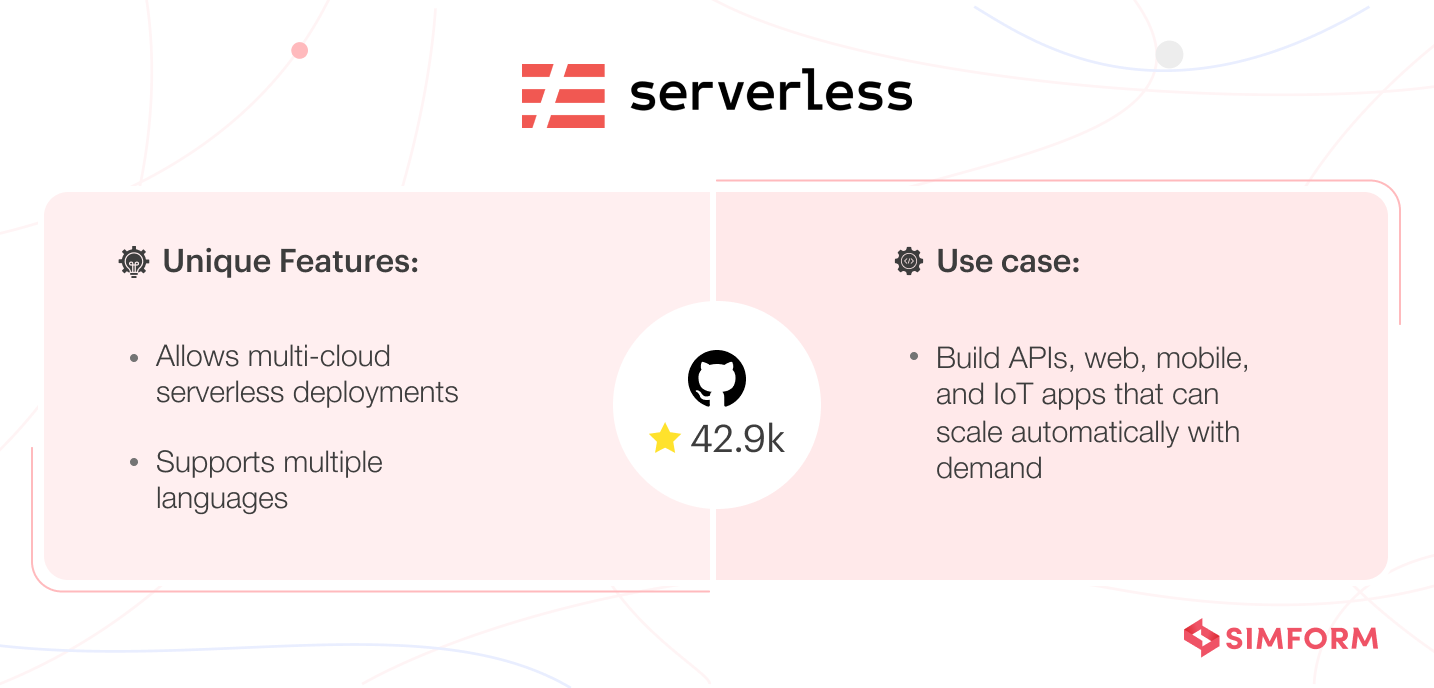 Initially developed to build applications on AWS Lambda, Serverless is now the most popular serverless framework. It helps you quickly develop, deploy, and manage serverless applications with Lambda and other FaaS platforms. It supports Azure Functions, Google Cloud Functions, Apache OpenWhisk, Kubeless, and more.
Initially developed to build applications on AWS Lambda, Serverless is now the most popular serverless framework. It helps you quickly develop, deploy, and manage serverless applications with Lambda and other FaaS platforms. It supports Azure Functions, Google Cloud Functions, Apache OpenWhisk, Kubeless, and more.
Serverless Framework automatically creates the infrastructure needed for your configured functions and events. So you can build sophisticated, event-driven apps or microservices that will auto-scale based on demand. It is also provider-agnostic, allowing you to package and deploy applications across multiple clouds, for example, Google Cloud, Azure, AWS, etc.
Moreover, you can extend its use cases by modifying the framework’s behavior via plugins. Serverless has a large ecosystem of serverless framework plugins for building use cases currently not supported.
Serverless Framework is used by top companies such as Coca-Cola, Reuters, Nordstrom, Expedia, and more. For example, GoDaddy used it to manage serverless deployments– to configure and deploy AWS services, test code locally, and easily package and deploy code changes.
Unique features:
- Free and open-source, supported by a large community
- Simple, abstract syntax in YAML
- Supports multiple languages such as Node.js, Python, Java, Go, C#, Scala, Kotlin, Swift, PHP, and more
- CLI (command-line interface) for structure, automation, and out-of-the-box practices
- Dashboard for a centralized view of infrastructure, performance, logs, errors, etc
- Numerous useful built-in commands and monitoring tools
- Allows Infrastructure as Code (IaC)
- Extensible via plugins
Use cases of Serverless Framework
- Event streaming pipelines
- Image and video manipulation
- IoT applications
- Processing events and SaaS
- Multi-language apps
- CI/CD deployment
2. AWS Serverless Application Model (SAM)
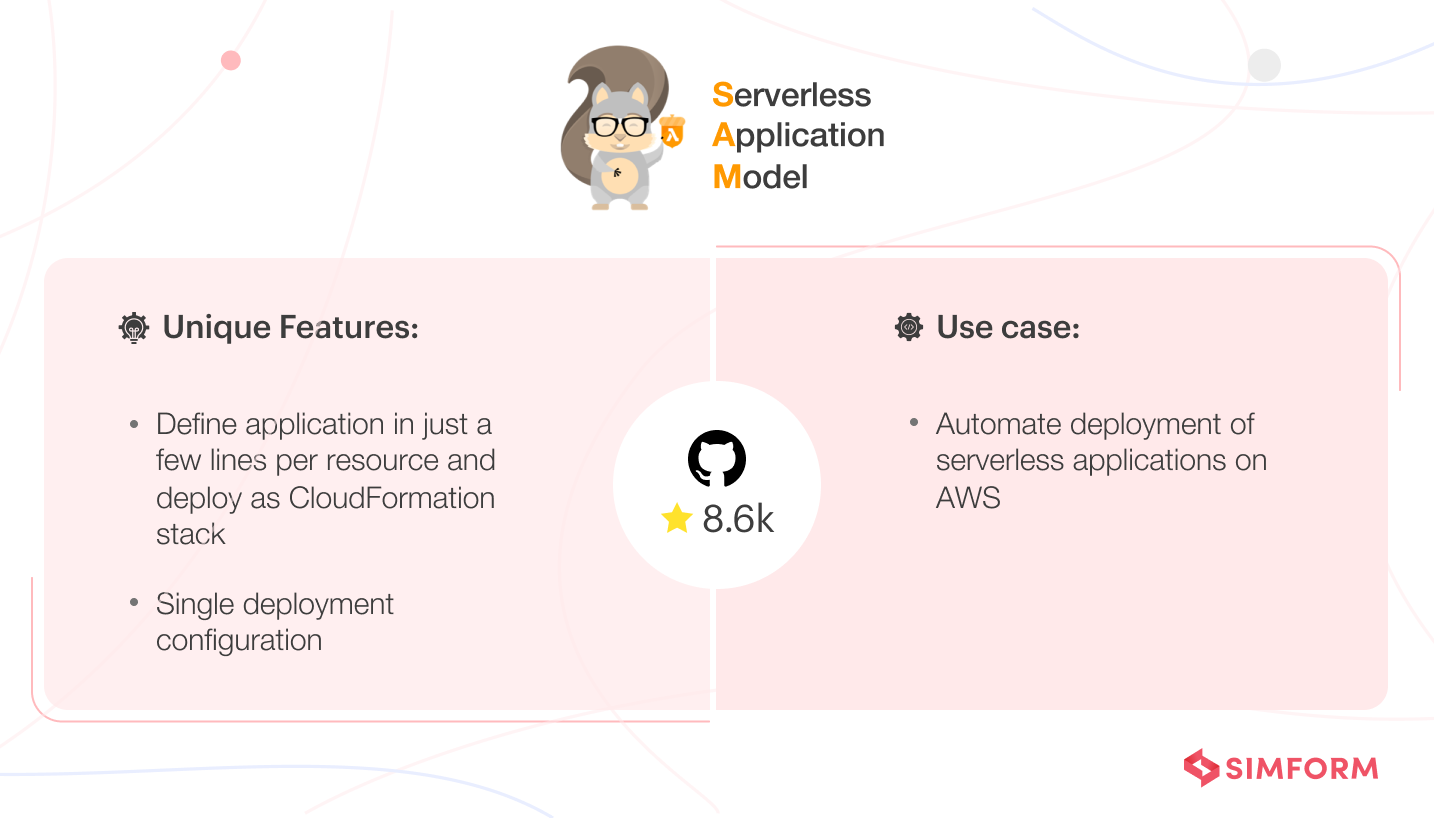 Simply put, AWS SAM is one of the AWS serverless frameworks that simplifies building serverless applications that work with multiple AWS services. As the official serverless computing and deployment framework from AWS, this serverless framework architecture facilitates the development, deployment, and debugging of serverless applications in the AWS ecosystem.
Simply put, AWS SAM is one of the AWS serverless frameworks that simplifies building serverless applications that work with multiple AWS services. As the official serverless computing and deployment framework from AWS, this serverless framework architecture facilitates the development, deployment, and debugging of serverless applications in the AWS ecosystem.
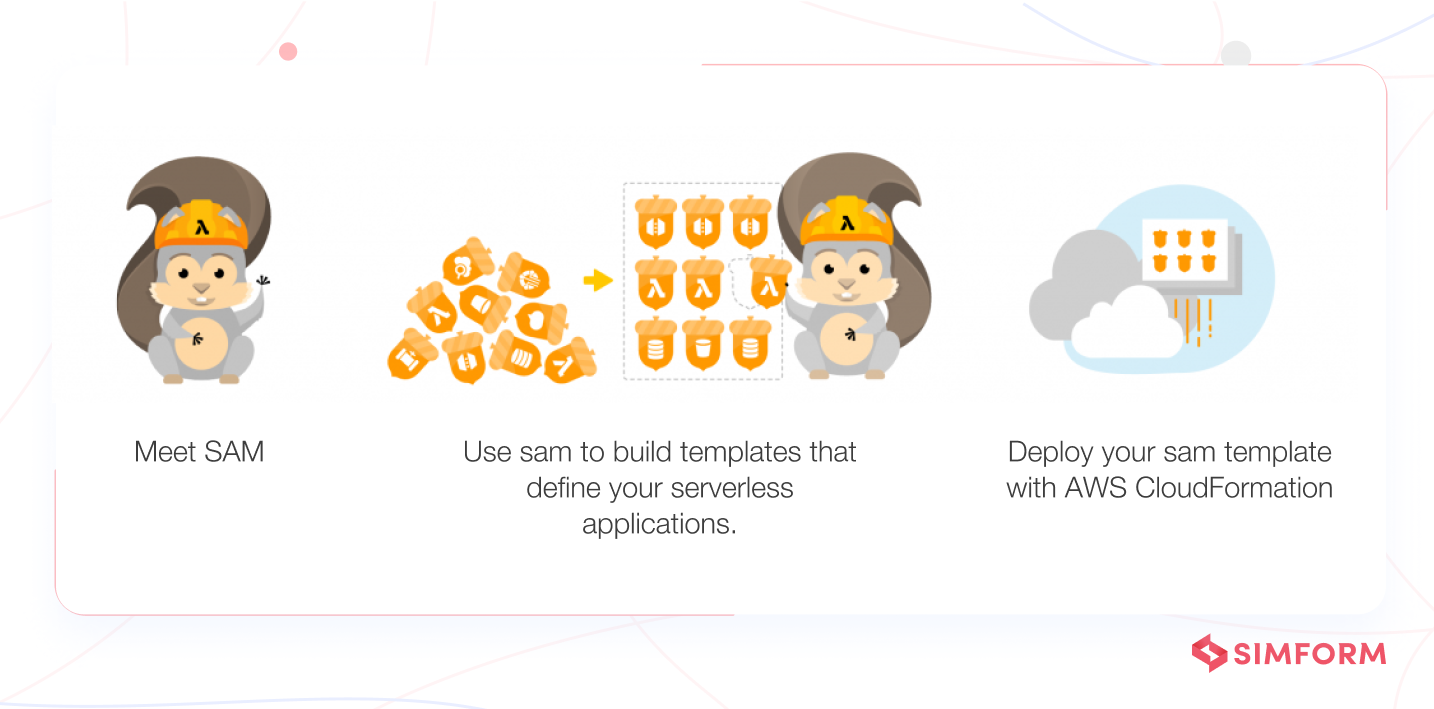 SAM’s shorthand syntax allows developers to define resources in just a few lines, which may take a hundred lines in AWS CloudFormation. You can build various applications with AWS SAM, including robust event-driven asynchronous tasks. Moreover, it supports image-based Lambda functions using Docker, further simplifying serverless development.
SAM’s shorthand syntax allows developers to define resources in just a few lines, which may take a hundred lines in AWS CloudFormation. You can build various applications with AWS SAM, including robust event-driven asynchronous tasks. Moreover, it supports image-based Lambda functions using Docker, further simplifying serverless development.
Unique features:
- Single deployment configuration, as all related resources are versioned together as a single entity
- Seamless integration with CI/CD pipelines
- SAM CLI that provides a Lambda-like execution environment facilitating local building, testing, and debugging of applications defined by SAM templates or AWS CDK
- SAM Accelerate for cloud based development, that enables developers to test code changes in the cloud and bypass local emulation for serverless applications
- Integrates with a suite of other AWS serverless tools
- Has numerous useful in-built SAM CLI commands (such as sam init, sam logs, and sam package, among popular ones)
- Inherent AWS security best practices
- Integrates with CDK
- Access to a list of policy templates to scope permissions for Lambda functions
Use cases of AWS SAM
The framework is widely used to automate the deployment of serverless applications based on AWS Lambda, API Gateway, DynamoDB tables, and S3 services. Below are a few scenarios where AWS SAM would be a good fit:
- For deploying multiple Lambda as a part of a larger application
- If you want to use CloudFormation as IaC tool
- If there is no creation of resources outside of AWS
3. Terraform
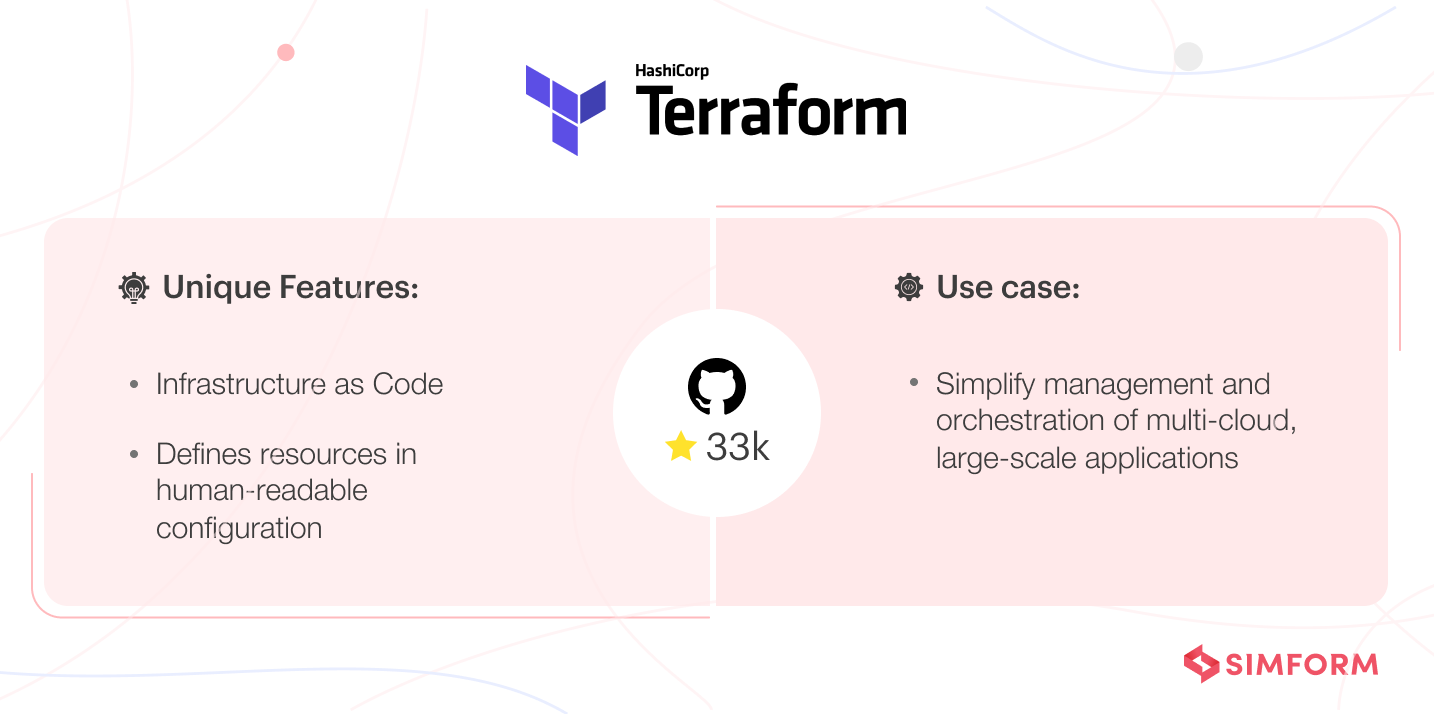 Popularly known as an IaC service, Terraform is an automation scripting tool similar to AWS CloudFormation. It is used to create, deploy, and manage cloud infrastructure across multiple cloud providers and services.
Popularly known as an IaC service, Terraform is an automation scripting tool similar to AWS CloudFormation. It is used to create, deploy, and manage cloud infrastructure across multiple cloud providers and services.
Terraform integrates with major cloud vendors, including AWS, Azure, Google Cloud Platform (GCP), Alibaba Cloud, Oracle Cloud, Kubernetes, etc. So, you can deploy and manage multi-cloud, large-scale infrastructures. It also allows you to scale and monitor multi-tier app architectures seamlessly.
Moreover, Terraform lets you spin up parallel environments rapidly for development, QA, testing, and production. Thus, as the environments grow more complex, creating disposable ones can prove more cost-efficient than maintaining them indefinitely. And you can also deploy and manage Kubernetes clusters with Terraform.
It is a popular tool among companies such as Slack, Robinhood, Udemy, Medium.com, Decathlon, and more. For instance, Uber uses a mix of Terraform and other internal tools to manage its hybrid cloud computing infrastructure made of multiple cloud providers and active data centers.
Unique features:
- An open-source tool with a large community
- Human-readable configuration files with friendly, declarative syntax
- Features such as visible planning, graphing, and more
- Automates provisioning of serverless application resources and infrastructure deployments
- Safely and efficiently manages and provisions for infrastructure throughout the lifecycle
- Manages low-level components (storage, compute, networking resources) as well as high-level components (SaaS features, DNS entries)
- Allows you to create templates to break configurations into smaller chunks for better organization, maintainability, and reusability
Use cases of Terraform
- Build self-service clusters
- Enforce policy compliance and management
- Platform as a Service (PaaS) application setup
- Software-Defined Networking
- Create software demos
4. AWS Chalice
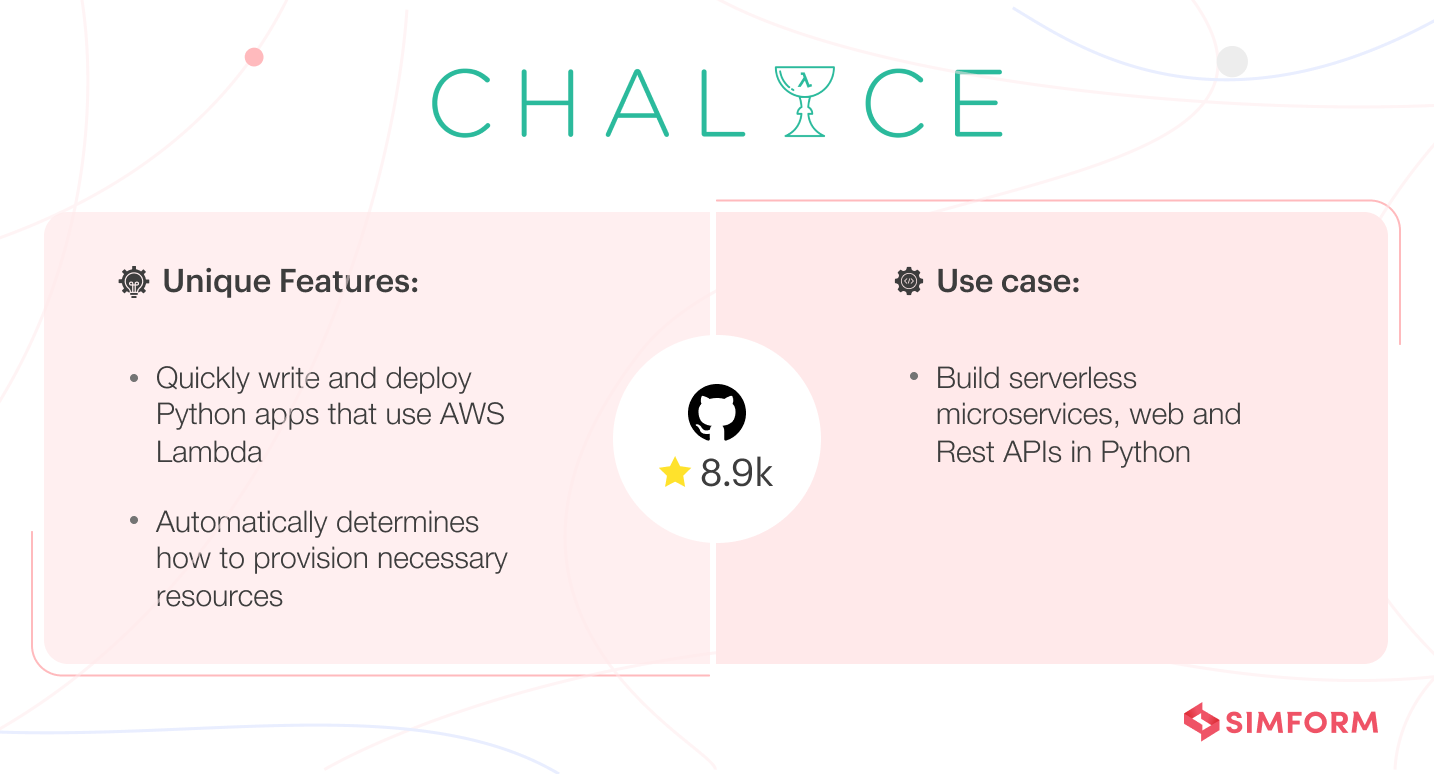 A project for Python lovers, AWS Chalice is a framework for building serverless applications in Python. It provides a microframework that allows you to quickly write and deploy applications using AWS Lambda and API Gateway.
A project for Python lovers, AWS Chalice is a framework for building serverless applications in Python. It provides a microframework that allows you to quickly write and deploy applications using AWS Lambda and API Gateway.
Chalice automatically provisions for the necessary resources, letting you run and deploy web apps and serverless microservices quickly. And with Chalice CLI, you can deploy REST APIs to AWS in minutes. You can also easily generate CI/CD pipelines as Chalice automatically generates deployment pipelines built with AWS CodePipeline and AWS CodeBuild.
For instance, CyberArk used Chalice for building serverless microservices and AWS CDK for the larger infrastructure. Chalice made it easier for the developers as they were shifting from on-prem to a cloud infrastructure. Other companies using Chalice include Dolead engineering and StatsRadio.
Since Chalice is centric to Python, the use cases may be limited to services built in Python.
However, it has some remarkable features:
- Built-in support for python packaging tools
- Familiar decorator-based syntax which shortens the learning curve
- Integrates with AWS SAM, Terraform, CloudFormation, and more such tools
- Saves development time on defining resources separately
5. Claudia.js
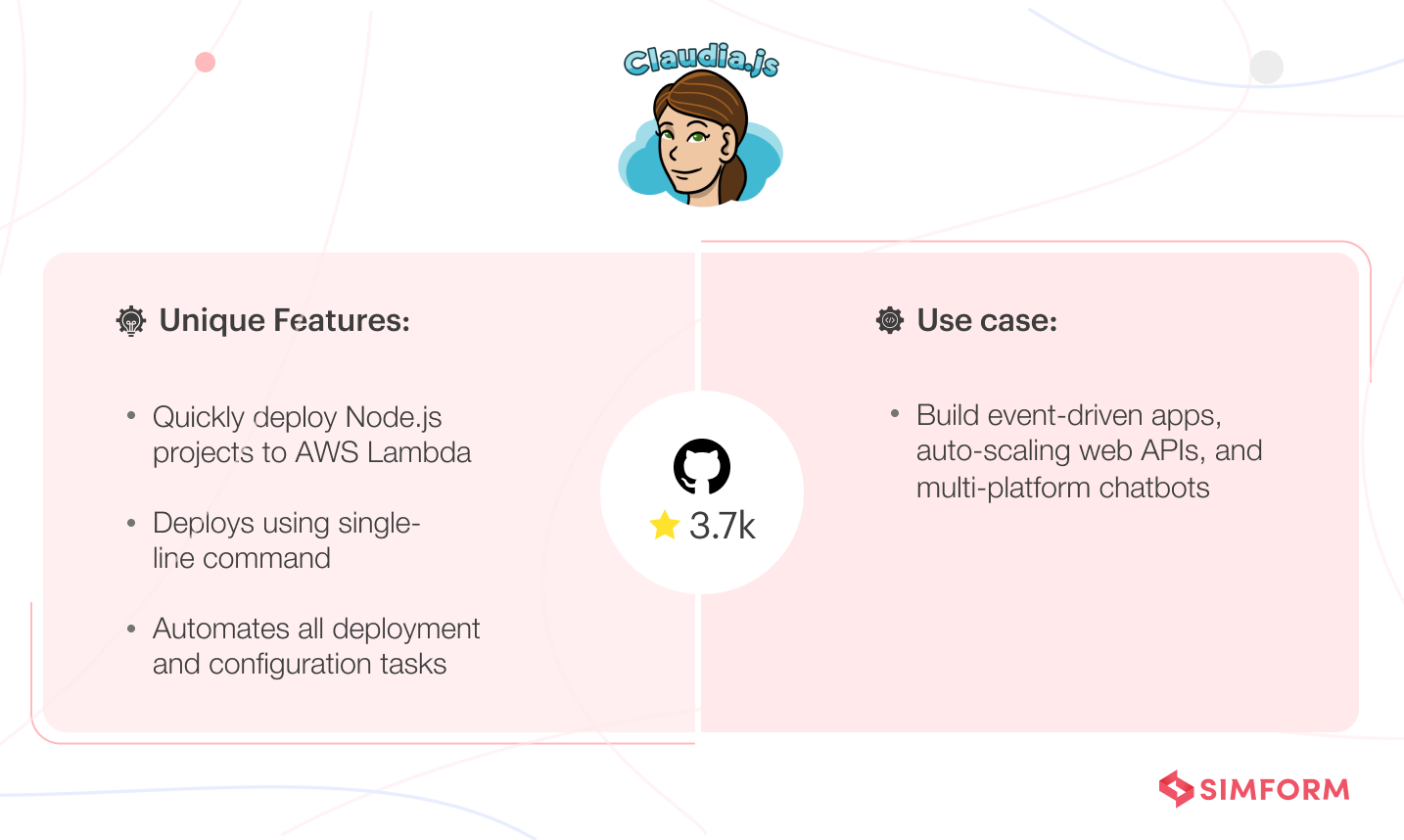 It is not a framework but more of a deployment utility. Claudia.js is an open-source tool that allows developers to deploy Node projects into AWS Lambda and API Gateway with just one or two lines of code (without knowing about the servers themselves).
It is not a framework but more of a deployment utility. Claudia.js is an open-source tool that allows developers to deploy Node projects into AWS Lambda and API Gateway with just one or two lines of code (without knowing about the servers themselves).
It automates deployment tasks and configuration and sets up the JavaScript environment automatically. Moreover, it can be run both as client-side code or serverless backend functions without worrying about hosting, scalability, etc. Thus, developers can develop and deploy event-driven apps and auto-scaling web APIs quickly with ease of mind.
At Codepen, Claudia and AWS Lambda proved the perfect solution for the development teams’ problems. Earlier, the frontend engineers waited for the DevOps engineer to write scripts, set up servers, and automate tasks required for deployments. But Claudia enabled them to do everything themselves, letting them do more with their existing skill sets.
Claudia is also great for building multi-platform chatbots with Claudia Bot Builder. It is an extension library for the framework.
Unique features:
- Lightweight JavaScript framework
- Short and easy commands that enable deploying nodes with a single command line
- Works seamlessly with NPM packages
- Automates deployment and configuration of your Node applications with ease
- Allows plugins with extension libraries
- Easy version management
- Small learning curve
Use cases of Claudia.js
- Event processing
- Event-driven microservices
- Lambda microservices
- Automating development-related tasks
6. Zappa
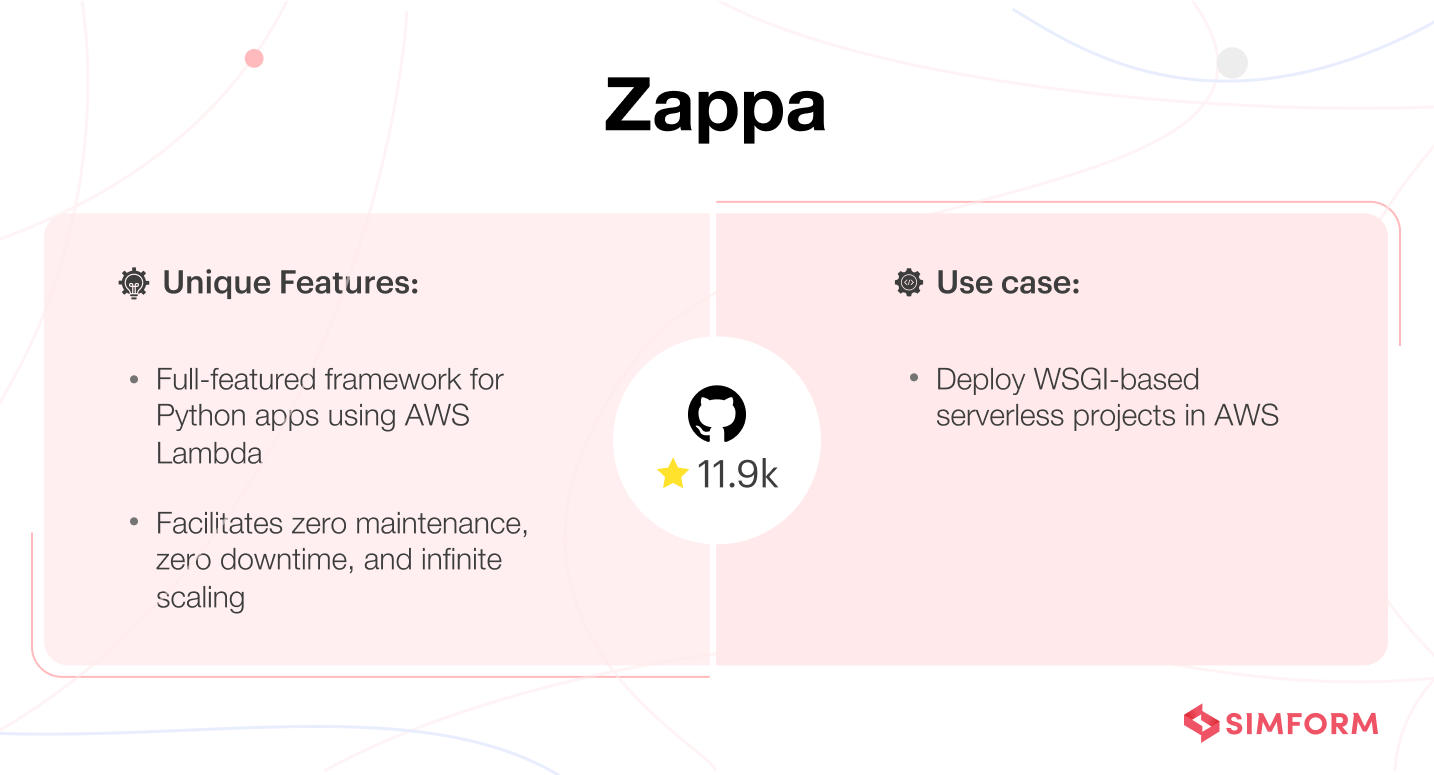 Another python framework, Zappa is easy-to-use and full-featured. It lets you seamlessly build and deploy event-driven serverless Python-based applications to AWS Lambda.
Another python framework, Zappa is easy-to-use and full-featured. It lets you seamlessly build and deploy event-driven serverless Python-based applications to AWS Lambda.
Zappa is also a popular framework for building WSGI( web server gateway interface) based apps and projects. It works with almost any WSGI-compatible framework, including Pyramid, Bottle, or even Django. Moreover, when combined with Flask, Zappa is great for creating serverless apps. hosting of complex web applications, image processing, text-processing, or number-crunching.
Zappa is used by various companies such as pop, Dubsmash, FoodRelay, REfindly, and OnCare. Pop decided to leverage Zappa as it offered a perfect mix of being full-featured and lightweight. And it also had various other benefits such as good documentation, automated deployments and rollbacks, and more.
Unique features:
- Automating deployment and updating applications on AWS servers
- Seamless integration with other Python frameworks
- Integration with CI/CD system
- Default IAM (identity and access management) policies for security
- Support for rollbacks, scheduling, logs tailing, remote function invocation, SSL certificates for custom domains, etc.
- Allows setting environment variables such as remote AWS environment or local environment
Use cases of Zappa
It tends to be popular for web-based applications or even REST API-like solutions. Other use cases include easy lift-and-shift of existing solutions to serverless, deploying serverless microservices, and more.
7. Jets
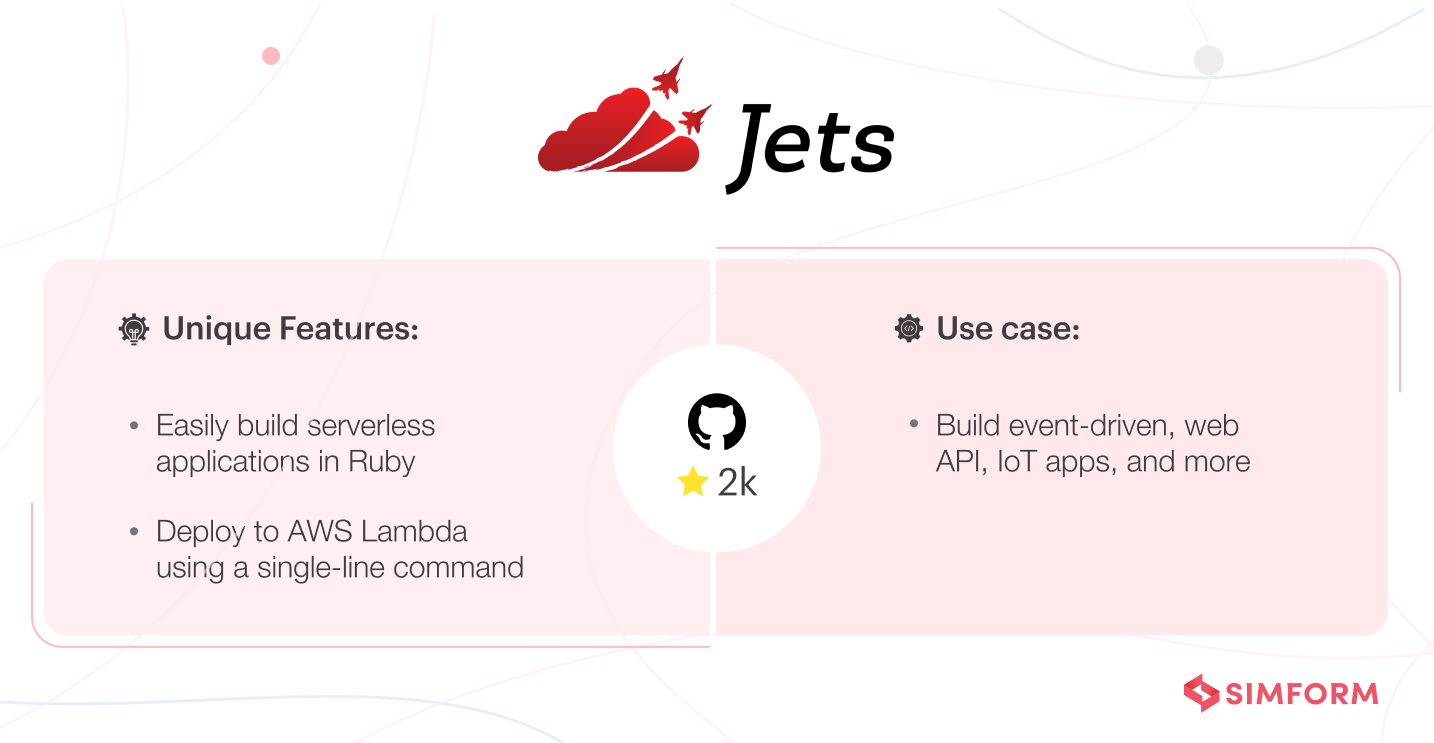 If you want to build serverless applications in Ruby, you can go for Jets. It is one of the best serverless frameworks that allows you to easily create apps in Ruby and deploy them, seamlessly gluing together with AWS services. Thus, it features all the necessary tooling to deploy applications using AWS Lambda framework.
If you want to build serverless applications in Ruby, you can go for Jets. It is one of the best serverless frameworks that allows you to easily create apps in Ruby and deploy them, seamlessly gluing together with AWS services. Thus, it features all the necessary tooling to deploy applications using AWS Lambda framework.
Developers can write the code in Ruby, and Jets turns it into Lambda functions and Amazon API Gateway resources. Thus, you can build various architecture patterns with Jets, including web API applications, event-driven apps or IoT architecture, and more.
Unique features:
- Focus on the dynamic language Ruby
- Extensive technical documentation with numerous examples
- More time for writing functional code
- Support for writing separate functions that you can use to join together different AWS resources and services
8. Architect
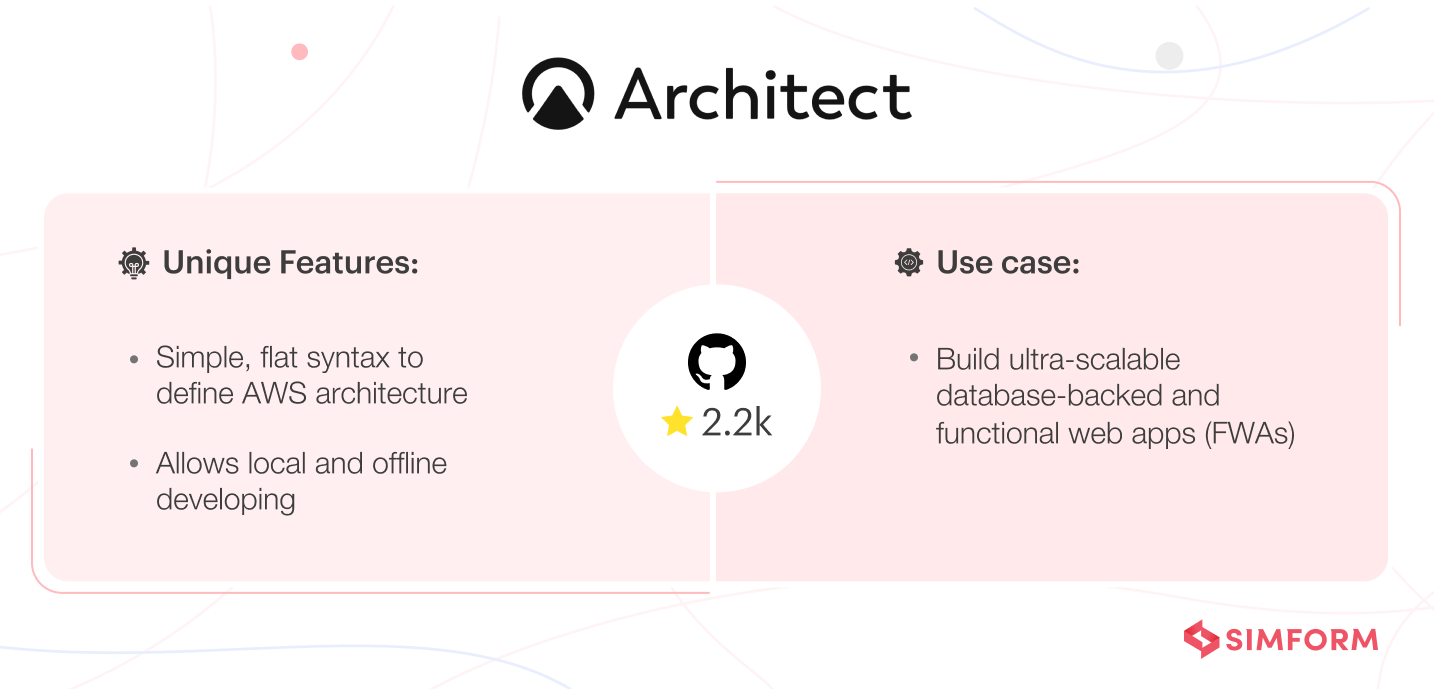 An advanced and sophisticated framework, Architect is a robust framework for building fast, modern, and scalable cloud-native apps. It allows developers to define when to use serverless architecture concisely with low code, zero ceremonies, and clear and terse config. Thus, they can focus on just business logic. Moreover, you pay only for services while in use, on-demand, or it scales to zero.
An advanced and sophisticated framework, Architect is a robust framework for building fast, modern, and scalable cloud-native apps. It allows developers to define when to use serverless architecture concisely with low code, zero ceremonies, and clear and terse config. Thus, they can focus on just business logic. Moreover, you pay only for services while in use, on-demand, or it scales to zero.
From the creators of begin.com, it features everything you need to build massively scalable serverless applications. In the words of one of its creators, Brian LeRoux, Architect is designed for building dynamic database-backed web applications. Technically, it is a higher-level wrapper for AWS SAM. So anything you can do with SAM, you can do in Architect. But the framework is particularly good at web apps.
Unique features:
- Open-source and open governance
- Flexible Infrastructure as Code
- Allows local and offline development, testing, debugging, and previewing of code before deployment
- Secured (IAM roles) with least privilege access to only the resources defined
Use cases of Architect
- Event-driven cloud applications
- Functional Web Apps on AWS
- Ultra-scalable, database-backed web apps
9. AWS Cloud Development Kit (CDK)
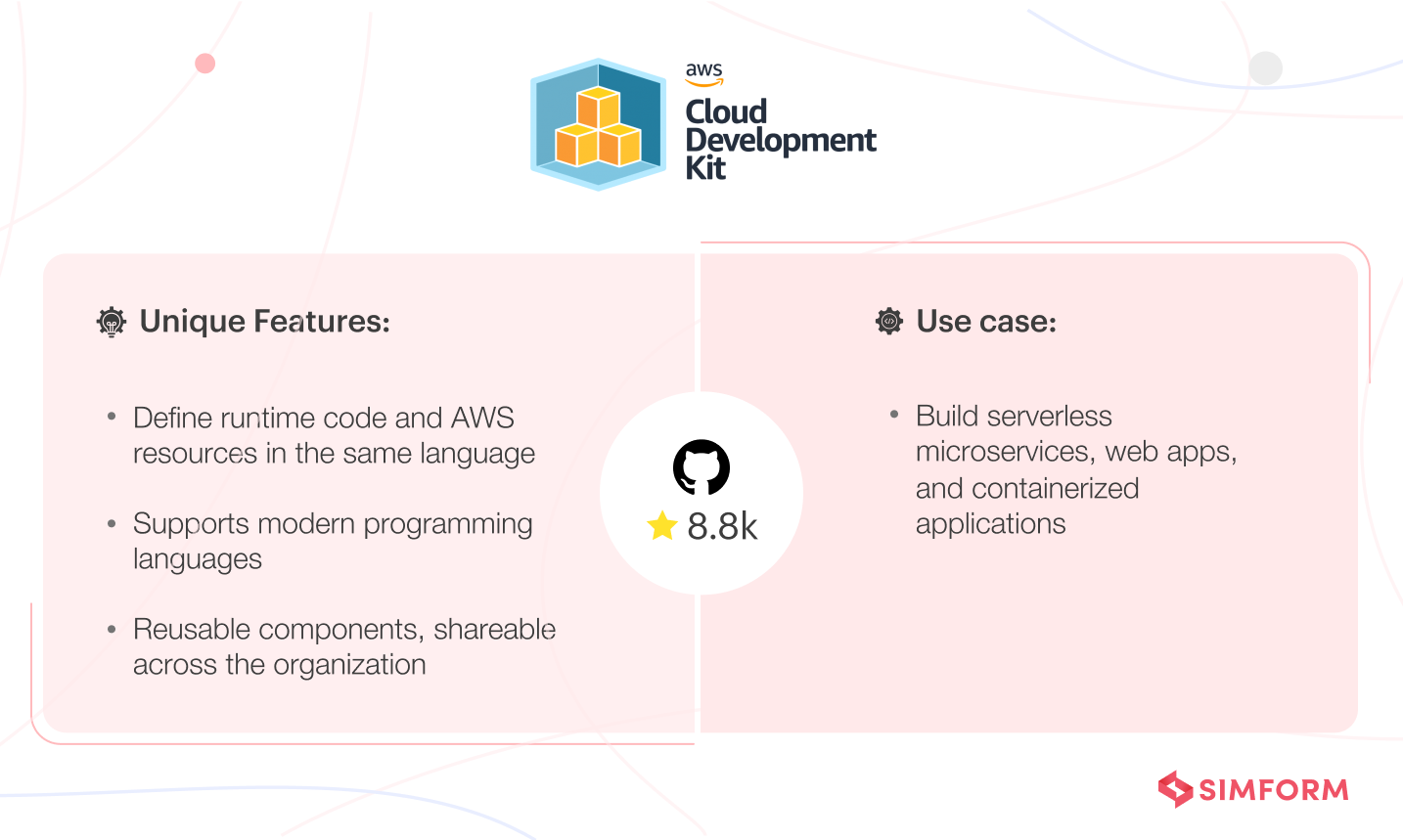 Another one from the AWS toolbox, AWS CDK is a software development framework where you define your cloud infrastructure using modern programming languages and deploy it using AWS CloudFormation. Thus, CDK is a good fit if you want to build serverless architectures on AWS using a language familiar to your developers. It allows you to create web apps, microservices, serverless utility functions, containerized applications, and more.
Another one from the AWS toolbox, AWS CDK is a software development framework where you define your cloud infrastructure using modern programming languages and deploy it using AWS CloudFormation. Thus, CDK is a good fit if you want to build serverless architectures on AWS using a language familiar to your developers. It allows you to create web apps, microservices, serverless utility functions, containerized applications, and more.
Many AWS companies have used CDK in their stacks, such as Cox Automotive, deepwatch, Culture Amp, Stedi, and CyberArk. At Currenxie, developers adopted CDK to write IaC in Typescript language as it was used to build its software. It empowered the developers to build applications quickly without learning a new framework or language and accelerated releases. Currenxie could build and release new features 30% faster since using AWS CDK.
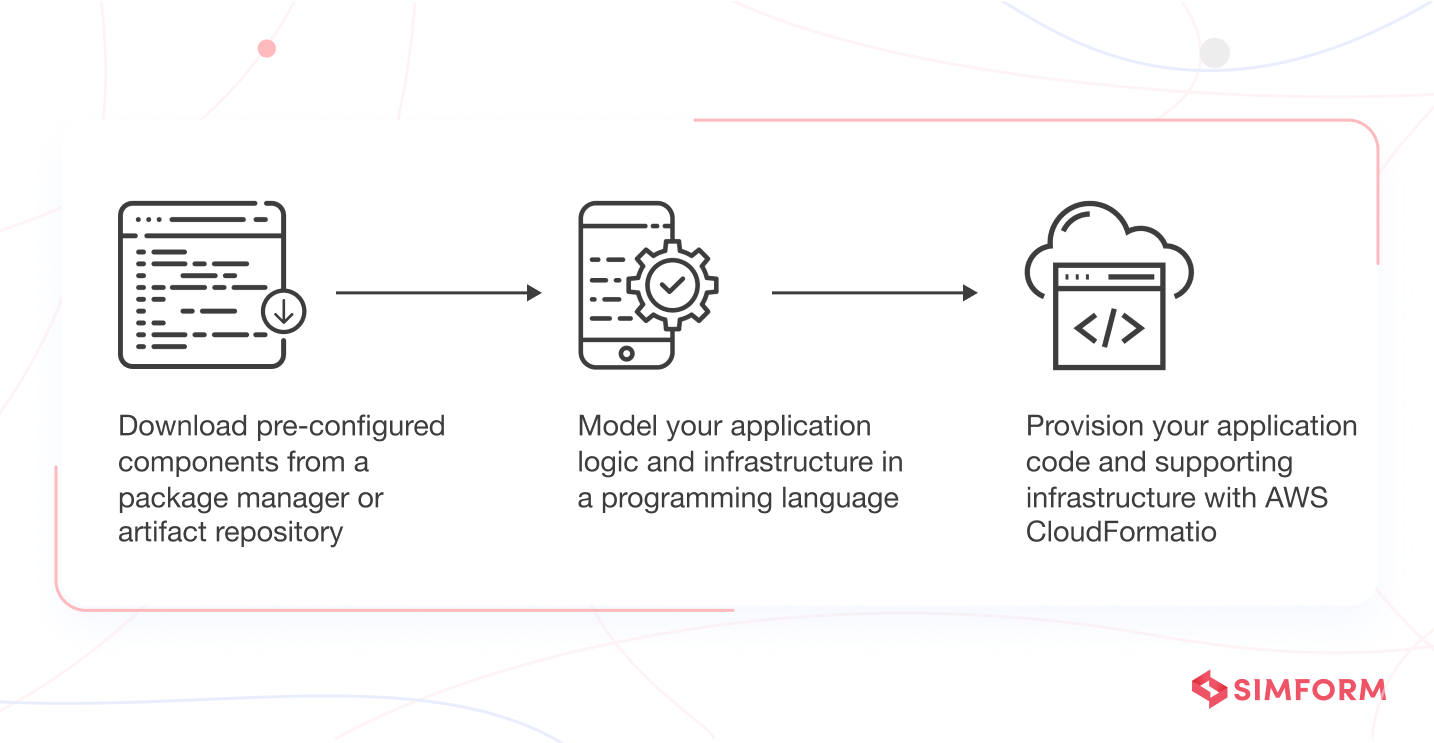
Unique features:
- Supports TypeScript, Python, Java, C#, and other programming languages
- Offers coverage across all AWS services and features
- Has a developer-friendly CLI
- Enables you to write runtime code and define AWS resources in the same programming language so you can deploy both runtime code and infrastructure together
- Allows you to design reusable components to cater to your organization’s security, compliance, and governance requirements and even easily share the components across your organization
- Allows you to embrace DevOps by involving more developers with IaC
- Integrates with continuous delivery pipelines using the AWS CDK CLI
10. Flogo
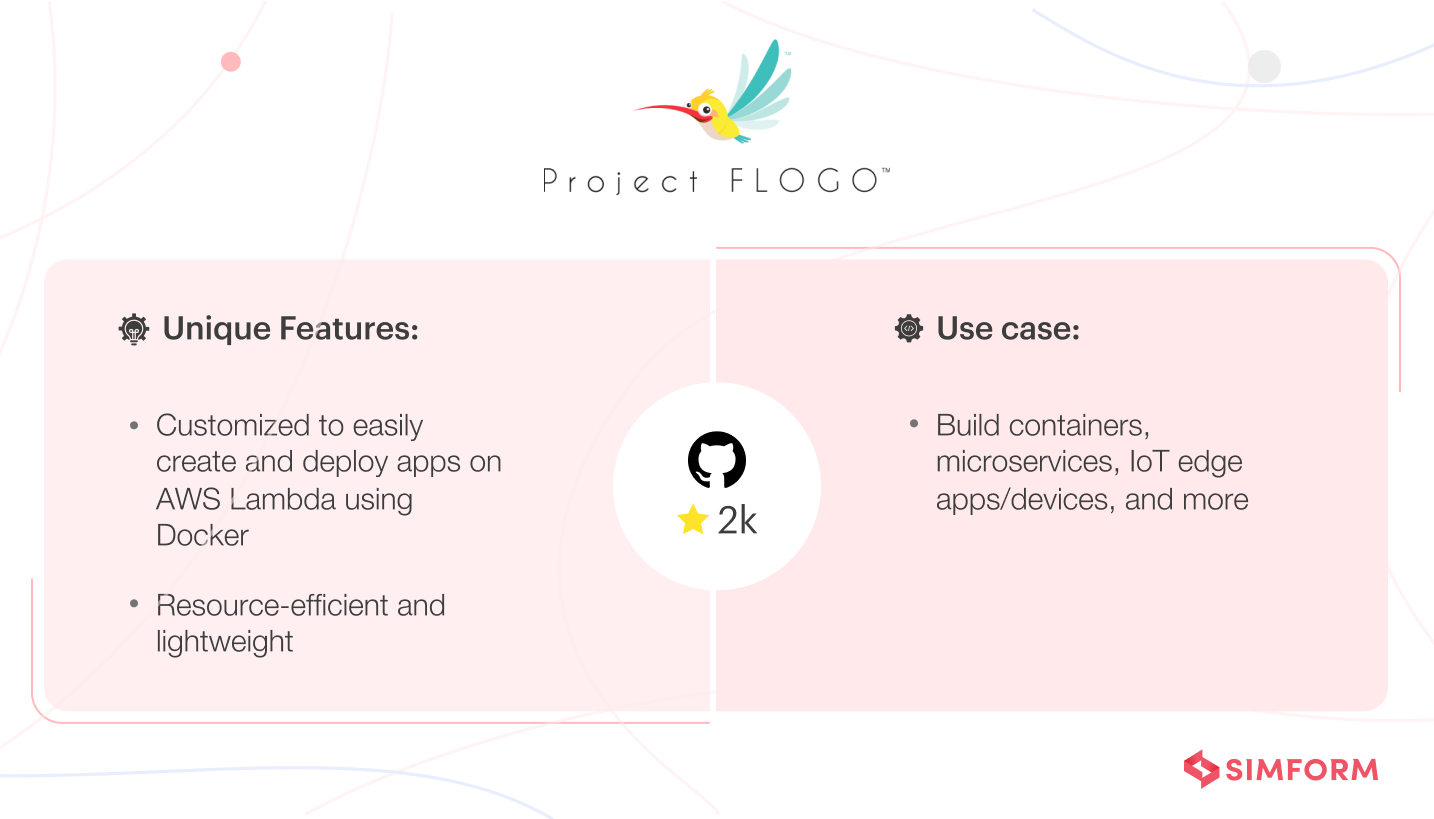 If you are building your serverless application with Docker, Flogo is for you. It is an open-source ecosystem with event-driven capabilities that simplifies building resource-efficient and modern serverless applications. Written in Golang language, it provides a customized framework to easily create, deploy and manage apps on AWS Lambda using only Docker images.
If you are building your serverless application with Docker, Flogo is for you. It is an open-source ecosystem with event-driven capabilities that simplifies building resource-efficient and modern serverless applications. Written in Golang language, it provides a customized framework to easily create, deploy and manage apps on AWS Lambda using only Docker images.
Many organizations have used Project Flogo to support their use cases, such as Thingstream, Liturgical publications, Biogen, Cosentino, and Campari Group. CargoSmart, for one, could apply AI to their IoT data to enhance user experiences with better decision-making. It used Flogo’s ability to easily embed machine learning (ML) models.
Unique features:
- Ultra-light design that is 20 to 50 times lighter than Node.js or Java
- Provides a visual web UI to design applications with the efficiency of Golang
- The small-footprint design provides an ultra-fast way to make your code live
- Offers the flexibility to deploy apps in containers, as serverless functions, or static binaries on IoT edge devices
Go serverless with Simform!
All the above frameworks aim to enable faster and seamless serverless deployment. However, they differ in terms of technicalities and use cases. To select the right serverless framework for your next project, you must consider factors such as– supported programming languages, community, pricing model, execution time, customizability, and control.
Your ideal serverless framework must enhance your developers’ experience as well as suit your business needs. For instance, whether it scales up and down dynamically with demand without extra effort, abstracts away configuration, manages servers, pays for resources only when used, etc.
Feel free to seek technical assistance from AWS experts for choosing a serverless framework suitable to your needs. Simform is an Advanced AWS consulting partner with certified and experienced professionals that can help you pick the right tools for your serverless application. So get a free consultation with our experts today!
FAQs
Security is crucial in serverless applications. Frameworks offer built-in security features such as IAM policies and encryption options. However, developers should implement best practices like proper configuration management and vulnerability assessments to ensure compliance with industry standards.
Each framework has its limitations. Some may lack language support or advanced features for specific use cases. Additionally, reliance on specific cloud providers can limit portability. Developers must assess trade-offs and compatibility with project requirements carefully.
Comparisons among these frameworks depend on factors like application requirements, supported programming languages, and customization needs. For instance, Serverless Framework is user-friendly with multi-cloud support, while AWS SAM integrates seamlessly with AWS services but may lack flexibility compared to Terraform or Architect. Performance and scalability vary based on infrastructure and resource management efficiency.